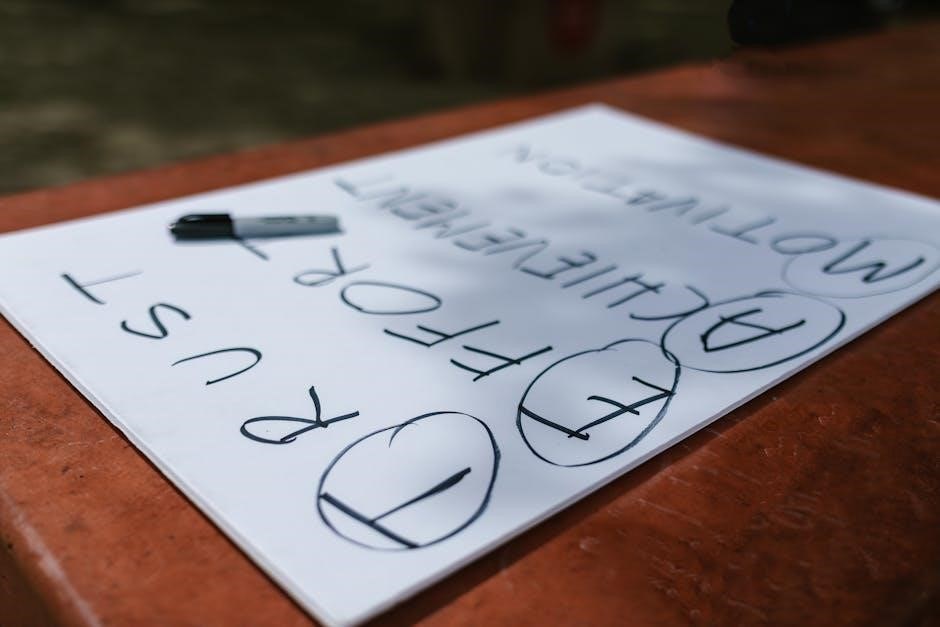Carl Jung introduced the concept of the Shadow, describing it as the repressed, hidden aspects of the human psyche, containing qualities we deny or hide. It is a central idea in his analytical psychology, emphasizing the unconscious mind’s role in shaping behavior and emotions. The Shadow is not inherently negative but represents the parts of ourselves we reject or conceal, often due to societal or personal expectations. Recognizing and integrating the Shadow is essential for self-awareness and personal growth, aligning with Jung’s broader vision of psychological health and individuation.
1.1. Definition of the Shadow in Jungian Psychology
The Shadow, as defined by Carl Jung, refers to the repressed, hidden aspects of the human psyche, comprising qualities, thoughts, and feelings an individual denies or conceals. It is a part of the unconscious mind, containing both positive and negative traits that are often rejected due to societal norms or personal ideals. The Shadow operates autonomously, influencing behavior and emotions outside conscious awareness. Jung described it as the “dark side” of personality, emphasizing its moral complexity and the need for integration to achieve psychological balance and self-awareness.
1.2. The Role of the Shadow in the Human Psyche
The Shadow plays a crucial role in the human psyche by housing repressed emotions, desires, and unresolved conflicts, influencing behavior and emotions unconsciously. It acts as a moral challenge, prompting individuals to confront their darker aspects. Without acknowledging the Shadow, it can lead to projection, where unwanted traits are attributed to others, causing interpersonal conflicts. Integrating the Shadow fosters self-awareness, emotional intelligence, and psychological balance, aligning with Jung’s concept of individuation, where the goal is to unify opposites and achieve wholeness.
1.3. Historical Context of Jung’s Work on the Shadow
Carl Jung developed the concept of the Shadow in the early 20th century, influenced by his break from Freud and his exploration of the unconscious mind. His work emerged during a time of growing interest in depth psychology, offering a revolutionary perspective on human nature. Jung’s personal experiences and analytical observations shaped his understanding of the Shadow, positioning it as a cornerstone of his theory. This concept was groundbreaking, as it provided a framework to address repressed emotions and the duality of human personality, profoundly impacting psychological thought.

Understanding the Shadow
The Shadow, as conceptualized by Carl Jung, represents the hidden, repressed aspects of the personality, containing qualities we deny or conceal. It embodies the “dark side” of human nature, housing unwanted emotions, desires, and traits. This archetype is universal, existing across cultures, and plays a crucial role in shaping behavior, often unconsciously. Recognizing the Shadow is essential for self-awareness and psychological integration.
2.1. The Shadow as the “Dark Side” of Personality
The Shadow, as described by Carl Jung, represents the “dark side” of personality, comprising repressed thoughts, desires, and traits we hide from others and ourselves. It contains qualities deemed unacceptable, such as anger, jealousy, or sexual impulses, often concealed due to societal norms or personal ideals. The Shadow is not inherently evil but rather a natural part of the psyche, shaped by our collective unconscious and individual experiences. Its presence influences behavior, causing internal conflict when these hidden aspects clash with our conscious values, highlighting the need for integration and self-awareness.
2.2. The Relationship Between the Shadow and the Ego
The Shadow and the Ego are interconnected yet opposing forces in Jungian psychology. The Shadow contains repressed aspects of the personality, while the Ego represents the conscious, socially acceptable self. The Ego often denies or hides the Shadow, leading to internal conflict and a fragmented psyche. Jung emphasized that the Ego must acknowledge and integrate the Shadow for psychological wholeness. This process reduces inner turmoil and promotes self-awareness, allowing the individual to move toward greater authenticity and balance. The interplay between these two elements is crucial for personal growth and emotional health.
2.3. The Collective Unconscious and the Shadow Archetype
Carl Jung’s concept of the collective unconscious introduces the idea of shared archetypes, universal symbols, and experiences common to all humans. The Shadow archetype, a key component of this collective unconscious, represents the dark, repressed aspects of the human psyche. It embodies qualities we hide, deny, or fear, existing beyond personal experiences. Recognizing the Shadow archetype allows individuals to access deeper layers of the collective unconscious, fostering self-awareness and understanding of shared human struggles. This archetype is a bridge between personal and universal psychological phenomena.
The Process of Shadow Work

Shadow work involves self-reflection, exploring repressed emotions, and integrating hidden aspects of the psyche for conscious integration, leading to emotional healing and personal growth.
3.1. What is Shadow Work?
Shadow work, rooted in Carl Jung’s analytical psychology, is the process of exploring and integrating the repressed, hidden aspects of the unconscious mind. It involves confronting and acknowledging the darker, often undesirable traits of the personality, which are typically concealed from conscious awareness. Through self-reflection, journaling, dream analysis, and mindfulness, individuals aim to recognize and reconcile these shadow elements. The goal is to bring these hidden parts into conscious awareness, fostering emotional healing, personal growth, and psychological wholeness. This process is essential for achieving Jung’s concept of individuation.
3.2. The Importance of Recognizing and Integrating the Shadow
Recognizing and integrating the Shadow is vital for achieving psychological wholeness and emotional healing. By confronting repressed thoughts, feelings, and desires, individuals can reduce self-destructive tendencies, improve relationships, and enhance self-awareness. Ignoring the Shadow often leads to projections, where unwanted traits are attributed to others. Integrating the Shadow promotes authenticity, allowing individuals to embrace their full humanity. Jung emphasized that until the Shadow is acknowledged and incorporated, it remains a hidden force controlling behavior, hindering personal growth and true self-understanding.
3.3. The Three-Step Process for Identifying Personal Shadows
Jung’s three-step process for identifying personal shadows involves self-reflection, exploration of projections, and engaging with the unconscious. First, individuals must acknowledge repressed emotions and thoughts they deny or hide. Second, they examine how they project these qualities onto others. Finally, they explore the unconscious through dreams, journaling, or meditation to uncover hidden aspects of the self. This process fosters awareness and integration, enabling individuals to embrace their full humanity and reduce the Shadow’s influence on their behavior.

Techniques for Practicing Shadow Work
Techniques include journaling, self-reflection, meditation, mindfulness, and dream analysis. These practices help individuals confront repressed emotions, explore projections, and integrate hidden aspects of their psyche effectively.
4.1. Journaling and Self-Reflection
Journaling and self-reflection are powerful tools for shadow work, allowing individuals to explore their unconscious thoughts and emotions. By writing down dreams, emotions, and experiences, one can identify repressed feelings and patterns. This practice helps in acknowledging hidden aspects of the personality, fostering self-awareness and personal growth. Regular reflection encourages honesty with oneself, making it easier to confront and integrate the shadow, aligning with Jung’s emphasis on introspection for psychological health.
4.2. Dream Analysis and Symbolism
Dream analysis is a cornerstone of shadow work, as it reveals the unconscious mind’s hidden dynamics. Carl Jung emphasized that dreams contain symbols and imagery representing repressed emotions, desires, and unresolved conflicts. By interpreting these symbols, individuals can uncover aspects of their shadow, gaining insight into their unconscious motivations. This process allows for a deeper understanding of the self, facilitating the integration of the shadow into conscious awareness and promoting psychological balance and wholeness.
4.3. Meditation and Mindfulness Practices
Meditation and mindfulness are powerful tools for engaging with the shadow, allowing individuals to observe unconscious patterns and emotions without judgment. These practices help quiet the mind, making it easier to access repressed thoughts and feelings. By cultivating present-moment awareness, one can confront hidden aspects of the self, fostering integration and balance. Jung emphasized the importance of inner exploration, and mindfulness practices align with this philosophy, promoting self-awareness and emotional healing through the conscious acknowledgment of the shadow.

The Impact of the Shadow on Behavior and Emotions
The shadow significantly influences behavior and emotions, often manifesting as repressed anger, fear, or shame. If unaddressed, it can lead to destructive actions and emotional turmoil, hindering personal growth and relationships. Recognizing and integrating the shadow is crucial for emotional healing and self-awareness, allowing individuals to confront hidden aspects and achieve psychological balance.
5.1. How the Shadow Manifests in Everyday Life
The shadow manifests in everyday life through unconscious behaviors, emotional reactions, and hidden fears. It often appears as projections onto others, where we attribute our repressed qualities to them. For instance, criticizing others for traits we deny in ourselves. The shadow can also surface in sudden anger, jealousy, or irrational fears, revealing unresolved inner conflicts. Additionally, it may influence self-sabotaging behaviors or attract toxic relationships, reflecting unconscious patterns. Recognizing these manifestations is key to understanding the shadow’s influence on daily interactions and emotional well-being, enabling individuals to address and integrate these hidden aspects for personal growth.
5.2. The Consequences of Unaddressed Shadow Issues
Unaddressed shadow issues can lead to internal conflict, emotional turmoil, and strained relationships. When repressed, the shadow may cause feelings of alienation, anxiety, or depression, as it silently influences thoughts and actions. Ignoring the shadow can result in self-sabotage, poor decision-making, and a lack of authenticity. It may also manifest as chronic anger, resentment, or passive-aggressive behavior, ultimately hindering personal growth and self-awareness. Over time, unresolved shadow issues can create a sense of disconnection from one’s true self and the world, underscoring the importance of confronting and integrating these hidden aspects for psychological well-being and balance.
5.3. The Connection Between Shadow Work and Emotional Intelligence
Shadow work enhances emotional intelligence by fostering self-awareness, a cornerstone of EI. Recognizing repressed emotions and thoughts allows individuals to better understand their triggers and responses, improving emotional regulation. By integrating the shadow, one gains insight into their hidden motives, reducing projection of negative qualities onto others. This awareness strengthens empathy and authenticity, key components of emotional intelligence. Shadow work thus deepens self-understanding, enabling more harmonious relationships and emotional balance, aligning with Jung’s vision of psychological wholeness and personal growth.

Case Studies and Examples
Case studies and real-life examples illustrate how shadow work manifests in individuals and society, offering practical insights into Jung’s concept. Historical figures, like Jung himself, demonstrate shadow integration, while modern applications show its relevance in leadership and personal growth, highlighting the universal nature of the shadow archetype.
6.1. Real-Life Examples of Shadow Work in Action
Real-life examples of shadow work reveal how individuals confront repressed emotions and traits, fostering personal growth and emotional intelligence; For instance, journaling and dream analysis are practical tools used to explore the shadow, allowing individuals to acknowledge hidden fears and desires. Through these practices, people often experience profound transformations, integrating their shadow aspects into their conscious awareness. Such real-world applications highlight Jung’s concept as a powerful framework for self-discovery and psychological healing.
6.2. Historical Figures and Their Shadows
Historical figures often exemplify the shadow in action, revealing how repressed traits influence their decisions and legacies. Carl Jung himself explored his own shadow, documenting his journey in “The Red Book.” Napoleon’s ambition and quest for power, driven by unconscious fears, illustrate the shadow’s manifestation. Similarly, Gandhi’s struggle with inner darkness, as revealed in his autobiography, shows the shadow’s presence even in revered leaders. These examples highlight how acknowledging the shadow can lead to greater self-awareness and transformation, aligning with Jung’s theories on psychological integration.
6.3. Cultural and Societal Implications of the Shadow
The shadow concept extends beyond individuals to cultures and societies, revealing collective repressions. Jung’s ideas suggest that societies, like individuals, have a collective shadow, manifesting in discrimination, inequality, and social unrest. Historical events, such as witch hunts or systemic oppression, reflect the projection of collective shadows onto marginalized groups. Addressing these shadows fosters societal healing and progress, encouraging acceptance of diversity and promoting psychological and cultural integration. This aligns with Jung’s vision of individuation on a communal level, emphasizing the importance of confronting and integrating collective darkness for a harmonious society.

The Relationship Between Shadow Work and Individuation
Shadow work is essential to Jung’s concept of individuation, as it involves integrating repressed aspects of the psyche to achieve wholeness and self-realization.
7.1. Jung’s Concept of Individuation
Carl Jung’s concept of individuation refers to the integration of the unconscious and conscious mind to achieve psychological wholeness. Central to this process is the recognition and integration of the Shadow, the repressed aspects of the personality. By confronting and accepting these hidden elements, individuals can attain self-awareness and fulfill their unique potential. Individuation is a lifelong journey toward becoming the complete and balanced person one was meant to be, essential for personal growth and emotional intelligence.
7.2. The Role of the Shadow in the Individuation Process
The Shadow plays a pivotal role in Jung’s process of individuation, serving as a bridge between the conscious and unconscious mind. By acknowledging and integrating the repressed aspects of the personality, individuals can transcend psychological fragmentation; The Shadow holds the key to self-awareness, allowing individuals to confront their darker impulses and hidden strengths. This integration fosters a balanced psyche, essential for achieving wholeness and fulfilling one’s potential. The Shadow thus becomes a catalyst for transformation and growth in the journey toward individuation.
7.3. The Integration of Opposites in Shadow Work

The integration of opposites is central to shadow work, as it involves reconciling contradictory aspects of the psyche, such as good and evil, light and dark, or conscious and unconscious. This process allows individuals to acknowledge and harmonize repressed qualities, fostering psychological wholeness. By integrating opposites, one dissolves internal conflicts and embodies a balanced personality. This unity of opposites is a cornerstone of Jung’s concept of individuation, enabling individuals to transcend duality and achieve self-awareness, ultimately becoming a whole and integrated person.

Advanced Topics in Shadow Work
Exploring the Shadow’s role in leadership, archetypes, and modern psychology reveals its profound impact on collective dynamics and organizational behavior, offering deeper insights into human complexity.
8.1. The Shadow and Archetypes
Carl Jung’s concept of archetypes, universal symbols within the collective unconscious, deeply influences the Shadow. The Shadow itself is an archetype, representing repressed qualities and hidden aspects of the self. Archetypes shape the Shadow’s expression, as they embody primal patterns and images common to humanity. Understanding the interplay between archetypes and the Shadow reveals how these universal themes manifest personally, offering insights into unconscious motivations and desires. This connection highlights the Shadow’s role in the broader psychological landscape, bridging personal and collective experiences.
8.2. The Shadow in Leadership and Organizational Dynamics
The Shadow significantly impacts leadership and organizational dynamics, as it shapes how leaders and teams interact. Leaders often hide their vulnerabilities, fears, and darker impulses, projecting them onto others, which can create toxic work environments. Unacknowledged Shadows can lead to manipulation, mistrust, and fear within organizations. Addressing the Shadow in leadership involves recognizing and integrating these repressed qualities, fostering authenticity and empathy. This process can transform organizational cultures, promoting accountability and healthier dynamics, ultimately enhancing leadership effectiveness and team cohesion.
8.3. The Shadow and Modern Psychological Practices
Modern psychological practices increasingly incorporate Jung’s concept of the Shadow to address unconscious patterns and repressed emotions. Techniques like journaling, dream analysis, and mindfulness help individuals confront their Shadow, fostering self-awareness and emotional intelligence. This integration aligns with contemporary therapies focusing on holistic mental health, emphasizing the importance of acknowledging and working with the Shadow for personal growth and well-being.

Resources for Further Study
Explore Carl Jung’s works, such as “The Collected Works,” and discover online courses, workshops, and tools like journal prompts for deeper Shadow Work exploration and integration.
9.1. Recommended Reading on Carl Jung and the Shadow
Delve into Carl Jung’s seminal works, such as Explore online courses and workshops that delve into Carl Jung’s Shadow Work, offering insights into the unconscious mind. Platforms like Coursera and Udemy feature courses on analytical psychology, while specialized workshops focus on practical shadow integration. These resources provide guided meditations, journaling prompts, and expert-led discussions to help individuals confront and understand their shadow. Many courses include downloadable materials, such as PDF guides, to enhance learning. These digital programs are ideal for those seeking structured, self-paced exploration of Jung’s concepts. Various tools and exercises can aid in exploring the Shadow, such as journaling prompts, meditation, and dream analysis. Guided exercises like active imagination and shadow mapping help individuals confront repressed emotions. Online resources offer downloadable worksheets and reflection guides to deepen self-awareness. These tools encourage individuals to engage with their unconscious, fostering personal growth and integration of the Shadow. They provide structured methods to uncover hidden aspects of the psyche, aligning with Jung’s principles of self-discovery and emotional healing. Carl Jung’s Shadow concept remains vital, offering profound insights into the unconscious mind and personal growth, emphasizing the importance of integrating repressed aspects for emotional healing and self-awareness. Carl Jung’s concept of the Shadow has left an enduring legacy in psychology, influencing modern approaches to self-discovery and emotional intelligence. His ideas emphasize the importance of confronting repressed thoughts and feelings, fostering personal growth and integration. The Shadow’s relevance extends beyond clinical settings, inspiring personal development practices and cultural discussions. Jung’s work continues to resonate, offering a framework for understanding the unconscious and its role in shaping human behavior and emotions, ensuring his theories remain timeless and universally applicable in the pursuit of psychological well-being. Shadow work, rooted in Jung’s concepts, continues to evolve in modern psychology, offering deeper insights into the unconscious mind. Its integration with contemporary therapeutic approaches and digital platforms ensures its relevance in addressing mental health challenges. The growing interest in emotional intelligence and self-awareness further highlights its potential. By bridging traditional theory with innovative practices, shadow work remains a vital tool for fostering personal growth and understanding the complexities of human behavior in an ever-changing world. Integrating the Shadow is transformative, enabling individuals to embrace their full selves, fostering authenticity and psychological wholeness. By confronting repressed emotions and qualities, one gains self-awareness and emotional intelligence. Jung’s concept remains timeless, offering a pathway to healing and growth. Shadow integration is not just a therapeutic tool but a lifelong journey toward self-acceptance and harmony within. Its profound impact on mental health underscores its enduring relevance in modern psychology and personal development practices.9.2. Online Courses and Workshops on Shadow Work
9.3. Tools and Exercises for Personal Shadow Exploration
10.1. The Lasting Legacy of Jung’s Shadow Concept
10.2. The Future of Shadow Work in Psychology
10.3. Final Thoughts on the Importance of Shadow Integration
